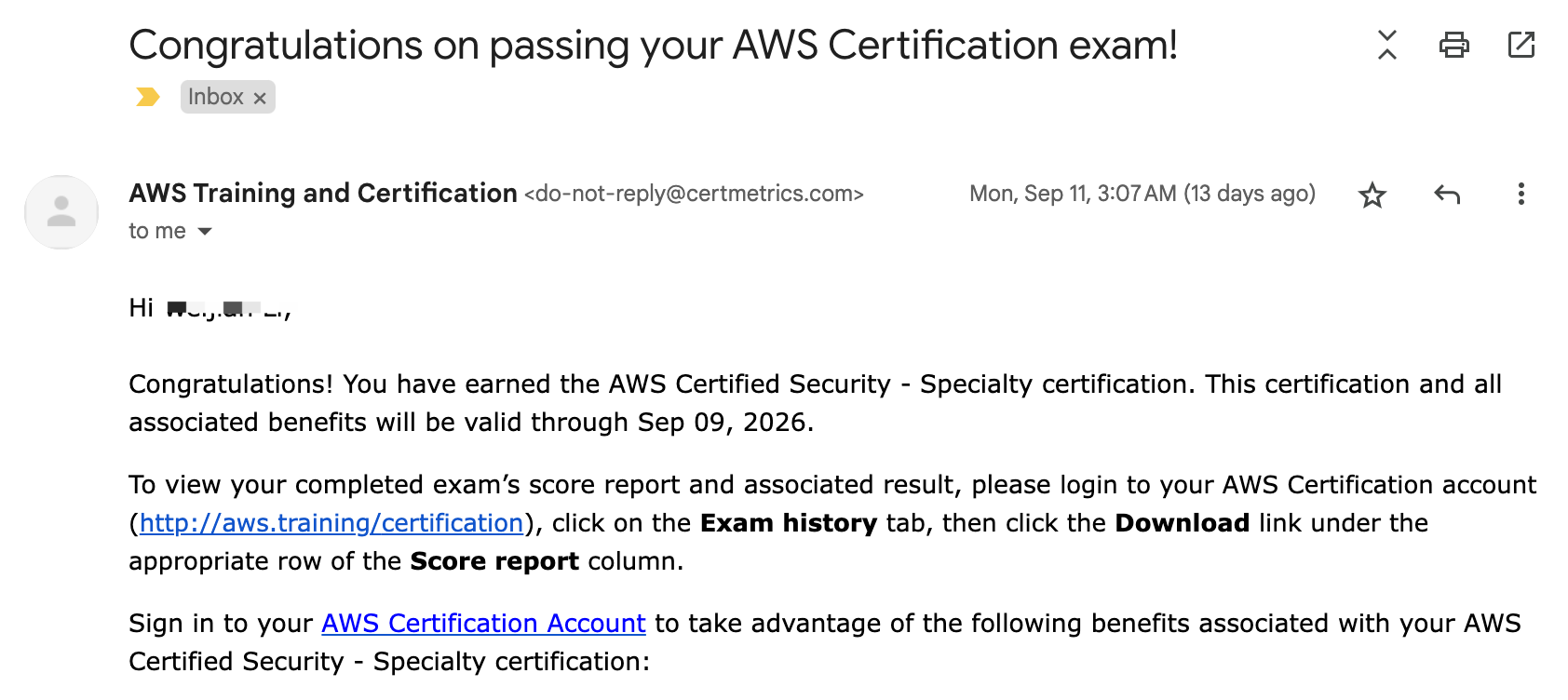- Published on
AWS Security Specialty: What I Learned Preparing for the Exam
- Authors

- Name
- Ted
- @supasaf
Not too long ago, I embarked on a perilous quest and returned victorious, with a shiny new digital badge to prove it. I passed the AWS Certified Security – Specialty exam.

Now, what would possess a sane person to willingly dive into hundreds of pages of technical documentation and spend weeks studying? At first, my eyes were drawn to this shiny little offer...

Just kidding! (Okay, maybe only half-kidding, who doesn't love a discount?) The real reason was a nagging feeling I couldn't shake. In my day job, I work with a hybrid mess of AWS, Azure, AliCloud, and even good old on-premise servers. I'd read the official docs to solve a problem and a little voice in my head would whisper, "Is this really the BEST way to do this, or just... A way?"
I was tired of just following recipes. I wanted to be the chef. I wanted to understand the why behind cloud security architecture. So, I decided to take on the beast: the AWS Security Specialty exam.
For anyone else crazy enough to follow me down this rabbit hole, here's my story and some tips from the other side.
Finding Your Map: The 30,000-Foot View
Before you start hacking your way through the jungle of AWS services, you need a map. For me, that map was Dylan Shields' book, AWS Security. Seriously, this book is fantastic. It gives you that 30,000-foot view of the entire security landscape. It's so good, it inspired one of my previous posts on the IAM Split-Privilege Model. Read it first. It will help you see how all the pieces fit together before you get buried in the details.
Surviving the Jungle: Key Areas That Will Try to Eat You Alive
The exam scope is massive. Everything is connected, and the questions are tricky—they love to mix and match services to see if you're really paying attention. Here are the big monsters you need to tame.
1. The Confusing Creature Zoo (Knowing Your Services)
AWS has a zoo full of services, and many of them look alike. This is where you'll spend most of your time. You don't need to be a zookeeper for every single creature, but you absolutely need to know which ones bite.
For example, the exam loves to test you on the trio of WAF, Shield, and CloudFront. They all play defense, but in different ways. Which one is best for stopping a massive DDoS attack? (Hint: Shield). Which one is for blocking SQL injection at the application layer? (Hint: WAF). Get them mixed up, and you're toast.
The same goes for the monitoring family: CloudTrail, CloudWatch, AWS Config, and Inspector. They all watch your stuff, but they watch for different things. Know their specific jobs, or they'll trip you up on the exam.
2. IAM and Policies (The Bouncer's Rulebook)
You absolutely, positively must become a master of IAM. It's the bouncer at the door of your entire cloud club. Understand the relationship between Users, Groups, Roles, and Policies. The policy evaluation logic is king here. Just remember this simple rule:
An explicit Deny beats everything.
I don't care if a user has five different Allow policies. If there is just ONE Deny statement that applies, they are NOT getting in. It's the ultimate trump card. Fully understanding this—not just memorizing it—is critical.
3. KMS (The Master Locksmith)
Key Management Service is where AWS keeps all the keys to the kingdom. You need to know the difference between the symmetric keys (a simple key for locking and unlocking) and asymmetric keys (a public/private key pair for more complex stuff). The exam will test you on key rotation, storage, and which key type to use for which service. It's another area full of easy-to-confuse details.
4. Data Security (The Three Flavors of Encryption)
When it comes to encrypting data at rest, especially in S3, you'll hear about three main "flavors":
- SSE-S3: Amazon manages the key. It's simple and hands-off.
- SSE-KMS: You use a key from KMS. You get more control over the key's lifecycle and permissions. This is usually the recommended choice.
- SSE-C: "Customer-Provided Key." You are a control freak and want to manage the key yourself. You give the key to AWS for each request, but AWS doesn't store it. You need to know when to use which flavor.
5. The VPC Labyrinth (The Castle Blueprint)
And then there's VPC. This isn't just a topic; it's an epic saga. It's the foundation, walls, moats, and secret passages of your entire cloud castle. You need to be comfortable with all of it:
- VPC Basics (subnets, route tables, gateways)
- Connecting VPCs (Peering vs. Transit Gateway)
- Securing access (Security Groups vs. Network ACLs)
- Private connections (VPC Endpoints, PrivateLink)
- Monitoring traffic (VPC Flow Logs)
Don't skimp on VPC. A huge portion of securing AWS is just building your network correctly in the first place.
Was It Worth It?
Absolutely. Passing the exam is nice, but the real prize is the confidence you gain. It's the difference between blindly following a tutorial and truly understanding why you're building something a certain way. You stop being just a user of the cloud and start becoming an architect of it.
So if you're on the fence, I say go for it. It's a tough quest, but the loot at the end is well worth the battle. Good luck!